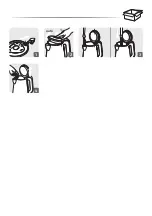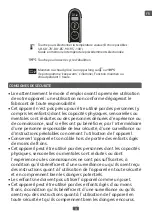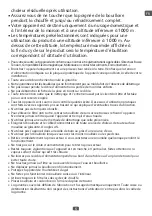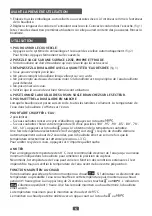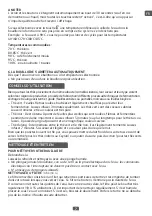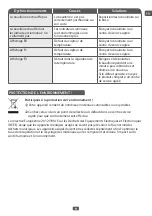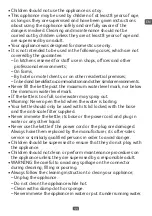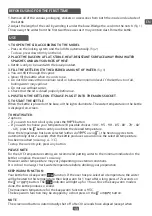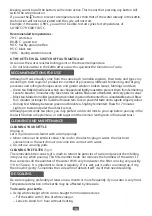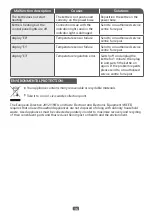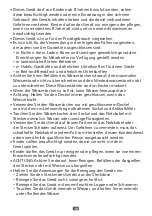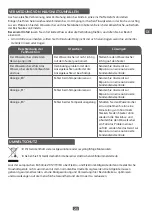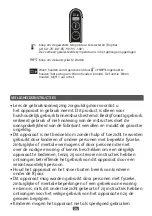
14
CLEANING AND MAINTENANCE
RECOMMENDATIONS FOR USE
CLEANING YOUR KETTLE
Unplug it.
Let it cool down and clean it with a damp sponge.
•
Never immerse the kettle, its base, the cord or the electric plug in water: the electrical
connections or the switch must not come into contact with water.
•
Do not use scouring pads.
CLEANING THE FILTER
(fig 4)
The removable filter consists of a mesh to retain the particles of scale and prevent them falling
into your cup when pouring. This filter neither treats nor removes the hardness of the water. It
thus conserves all the qualities of the water. With very hard water, the filter can clog very quickly
(10 to 15 uses). It is important to clean it regularly. If it is wet, put it under a running tap, if dry,
then brush it gently. Sometimes the scale will not detach itself; it will then need descaling.
Although all teas actually come from the same bush (camellia sinensis), their taste and type vary
according to their region of production, method of processing (different fermenting, and drying
processes and rolling techniques exist) and grade (whole or broken leaves, fannings and dust).
– Green tea: Rolled dried leaves, which are chopped and lightly roasted to prevent them from fermenting.
Leave to brew for 3 minutes only. Green teas are subtle- flavoured, often bitter, and very pale in colour.
– Black tea: Made from older leaves that are rolled, dried and fermented for a considerable period. Brew
for 5 minutes (or longer for Turkish or Russian tea). Gives a powerful taste and a superb coppery colour.
– Oolong tea: Midway between green and black tea. Slightly fermented. Brew for 7 minutes.
Lighter in taste and paler than black colour.
Although purists drink tea plain, you may prefer to add cold milk to your cup before pouring in the
tea (with Indian or Ceylon tea), or add sugar and then lemon (with green or flavoured teas).
DE-SCALING
De-scale regularly, preferably at least once a month or more frequently if your water is very hard.
Temperature detection in the kettle may be affected by limescale.
To de-scale your kettle:
• Using white vinegar which can be bought from hardware stores:
– Fill the kettle with ½ litre of white vinegar,
– Leave to stand for 1 hour without heating.
keeping warm) but all the buttons will remain active. This means that pressing any button will
switch the screen back on.
If you use the button to select a temperature less than that of the water already in the kettle,
the function will not be activated and the cycle will not start.
Example: if the water is 90°C, you will not be able to start cycles for temperatures of
40°/60°C/70°C/80°C/85°C.
Recommended temperatures :
70°C : white tea
80-85°C : green tea
90°C : freshly ground coffee
95°C : black tea
100°C : boiling water/infusions
6. THE KETTLE WILL SWITCH OFF AUTOMATICALLY
As soon as the water reaches boiling point or the chosen temperature.
•
Do not leave water in the kettle after use as this quickens the formation of scale.
Summary of Contents for Theia Control
Page 1: ...EN Theia Control kettle www tefal com DE NL ES FR DA NO SV PT IT FI EL ZH KO TH MS TR AR FA VI...
Page 2: ...1 4 2 3 1 auto...
Page 80: ...80 8 8 40 60 70 80 85 90 95 100 1...
Page 81: ...81 8 8 EL...
Page 82: ...82 1000 m 1000...
Page 83: ...83 1 2 2 3 3 4 5 2 8 100 95 90 85 80 70 60 40 2 3 C 40 C 1 2 1 95 C 1 2 1 EL...
Page 85: ...85 15 service service 1 25 g 15 5 6 EL...
Page 86: ...86 2012 19 E WEEE E0 E1 E3 1...
Page 101: ...101 8 8 8 ZH 8 40 60 70 80 85 90 95 100 1...
Page 102: ...102 1000 1000...
Page 103: ...103 1 2 1 1 2 2 3 3 4 5 2 8 100 95 90 85 80 70 60 40 2 3 40 2 1 1 95 60 ZH...
Page 105: ...105 5 6 ZH 15 WEEE 2012 19 EU E0 E1 E3 1...
Page 106: ...106 8 8 40 60 70 80 85 90 95 100 100 C Keep Warm 1...
Page 107: ...107 8 8 KO...
Page 108: ...108 1 2 1 1000m 1000m...
Page 111: ...111 15 AS KO...
Page 112: ...112 Waste Electrical and Electronic Equipment WEEE European Directive 2012 19 EU E0 E1 E3 1...
Page 113: ...113 8 TH 8 40 60 70 80 85 90 95 100 1...
Page 114: ...114 8 8...
Page 115: ...115 1000 1 000 TH...
Page 116: ...116 1 2 2 3 3 4 5 2 8 100 95 90 85 80 70 60 40 2 3 C 40 1 2 1 95 C 1 2 1...
Page 118: ...118 15 1 25 15 5 6...
Page 119: ...119 2012 19 EU WEEE E0 E1 E3 1 TH...
Page 120: ...120 WEEE 2012 19 EU E0 E1 E3...
Page 121: ...121 15 15 25 6 5 AR...
Page 122: ...122 4 10 15 3 5 7 85 80 70 60 40 90 70 85 80 90 95 100 6 6...
Page 123: ...123 1 1 2 2 2 3 3 3 4 4 5 5 85 80 70 60 40 8 100 95 90 3 40 95 30 1 AR...
Page 124: ...124 1000 1000...
Page 125: ...125 8 8 AR...
Page 126: ...126 8 60 40 8 100 95 90 85 80 70...
Page 127: ...127 WEEE 2012 19 EU E0 E1 E3 FA...
Page 128: ...128 15 TEFAL 15 25 6 5...
Page 129: ...129 15 10 3 7 1 85 80 70 60 40 90 70 85 80 90 95 100 6 6 FA...
Page 130: ...130 1 1 2 2 2 3 3 3 4 4 5 5 60 70 80 85 90 95 100 8 40 2 40 1 1 2 2 1...
Page 131: ...131 1000 FA...
Page 132: ...132...
Page 133: ...133 FA 90 85 80 70 60 40 8 100 95...


